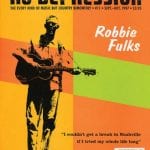Invisible Republic: Bob Dylan’s Basement Tapes
Invisible Republic is the 275-page accompanying booklet to a Bob Dylan box set that doesn’t exist. The subject of Marcus’ scholarly examination is a body of performances known collectively as the Basement Tapes. In the summer of 1967, having left the public eye after a highly publicized motorcycle crash (which some believe became a convenient excuse to regain his privacy), Bob Dylan and the Hawks (later to become the Band) began performing informally several times a week at Big Pink, a house in West Saugerties, New York, near Woodstock. For a period of five or so months, the musicians gathered and crudely recorded the music they were playing: new Dylan compositions, a handful of contemporary songs, and a lot of covers of what the book calls “American traditional music.”
It is the last to which Marcus gives most of his attention. His somewhat convoluted thesis is to show specific intent behind Dylan’s selection of these historical songs, and to suggest that, taken as a whole, Dylan and the Hawks’ exploration of American folk music traditions as performed on the Basement Tapes is a secret microcosm of our nation. He makes two essential and accurate observations up front, reminding us that Dylan never intended this music to be heard, and contrasting the sound and vision of the Basement Tapes with the rest of the world circa 1967 (Sgt. Pepper, the Summer of Love, Vietnam).
Marcus then proceeds to examine nearly every song performed at Big Pink, tracing the history (in often verbose detail) of the songs Dylan chose to cover. What he doesn’t do is pay enough attention to Dylan’s original compositions that emerged in the period, particularly those not released on the official 1975 Basement Tapes double album on Columbia. This is especially odd given that the bulk of the book is devoted to cover songs that weren’t included on the album. Marcus seems to be operating under the assumption that while they too remain “unheard,” he can bring them to life by detailing their history, quoting their lyrics, and providing biographical sketches of their originators. As a result, a Dylan masterwork such as “Sign on the Cross” earns but a single paragraph, while Clarence Tom Ashley’s “The Coo Coo Bird” merits a six-page examination.
Perhaps that’s the quibble of a devoted Dylan fan, but there’s no getting around that Invisible Republic is a listening guide to music most people can’t listen to. Following a weighty bibliography, Marcus begrudgingly acknowledges that the only extant collection of the Basement recordings (besides the official Columbia set) is the five-CD bootleg set The Genuine Basement Tapes, and he goes on to annotate that series track-by-track. But not before making a ridiculous aside to let us know that The Genuine Basement Tapes offers “the separated stereo of the original tapes, but without approaching the fullness and density of their sound.” Most readers will never get the chance to hear the bootlegs, but even for those of us lucky enough have a copy of the set, Marcus can’t resist pointing out that he alone has heard the “real” Basement Tapes.




